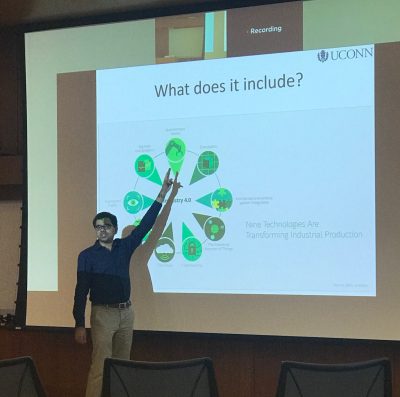On September 12th, Dr. Ashwin Dani spoke at the Industry 4.0 and Manufacturing Ingenuity course. The course, funded by CTNext, fosters innovation and entrepreneurship by providing students with exposure to emerging technologies in automation, cyber physical systems, and advanced manufacturing. The course is built upon seminars by invited industrial speakers to introduce cutting-edge technologies and challenges.
Dr. Dani is an Assistant Professor in the Department of Electrical and Computer Engineering at the University of Connecticut, Storrs. Prior to joining UConn, he was a Postdoctoral Research Associate at the University of Illinois at Urbana-Champaign. He received his B.S. in Mechanical Engineering from the University of Pune, India in 2005, and his Ph.D. in Mechanical and Aerospace Engineering at the University of Florida in 2011. His current research interests include human-robot collaboration and safety issues in manufacturing environments, GPS-denied navigation of unmanned aerial systems, improved autonomy, and supervisory control of building systems.
In his talk entitled “Role of Robotics & Automation in Industry 4.0”, Dr. Dani discussed the first 3 industrial revolutions. Then, he gave the origin of Industry 4.0, and defined it as a transformation that makes it possible to gather and analyze data across machines, enabling faster, more flexible, and more efficient processes to produce higher-quality goods at reduced costs. Industry 4.0 increases productivity and includes 9 technologies: simulation, cyber security, cloud, IoT, horizontal and vertical system integration, augmented reality, additive manufacturing, autonomous robots, and big data analytics.
Dr. Dani then went into detail about the history of robots and types of robots. The three types of robots discussed were manufacturing robots, service robots, and humanoid/walking robots. These robots can be further classified into two groups: static base and mobile robots. Static base robots are typically robot arms for manufacturing. The challenge with static base robots is finding a way to make them more efficient. On the other hand, mobile robots are simply robots that move. Challenges with mobile robots include kinematics, dynamics, control, and navigation.
He explained that robots have sensors that collect data, and that data needs to be processed. This leads to mapping and localization ̶ the robot figures out where it is and where it wants to be. Next, the robot plans a path to get to where it needs to go ̶ this is called cognition and path planning. The final step in the process is motion control.
Additionally, Dr. Dani touched upon simultaneous localization and mapping, as well as vision based control, which is using vision in the loop to control the actions of the robot. The process involves feature extraction from images, and there are two types: image-based control and position-based control.
To finish his talk. Dr. Dani presented a video of a robot learning how to grate cheese, whip eggs, and cut ham. His final message was “in the context of industry, you can teach robots to perform various applications”.
This week, Dr. Kenneth Creasy will be the seminar speaker. Dr. Creasy is the Senior Director of Manufacturing Technology and Innovation for Johnson & Johnson. His presentation will focus on scouting and incubation technology for the healthcare supply chain.
